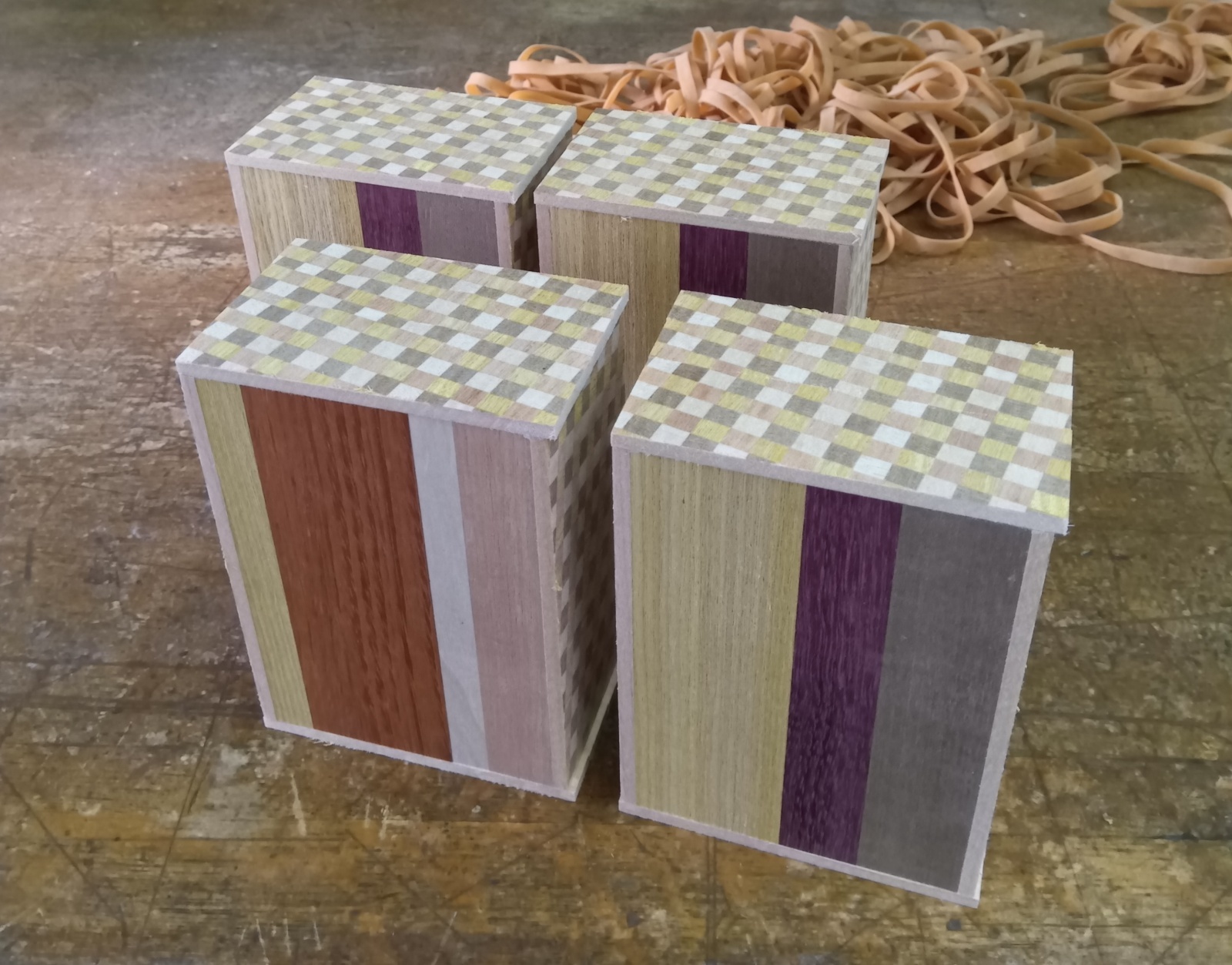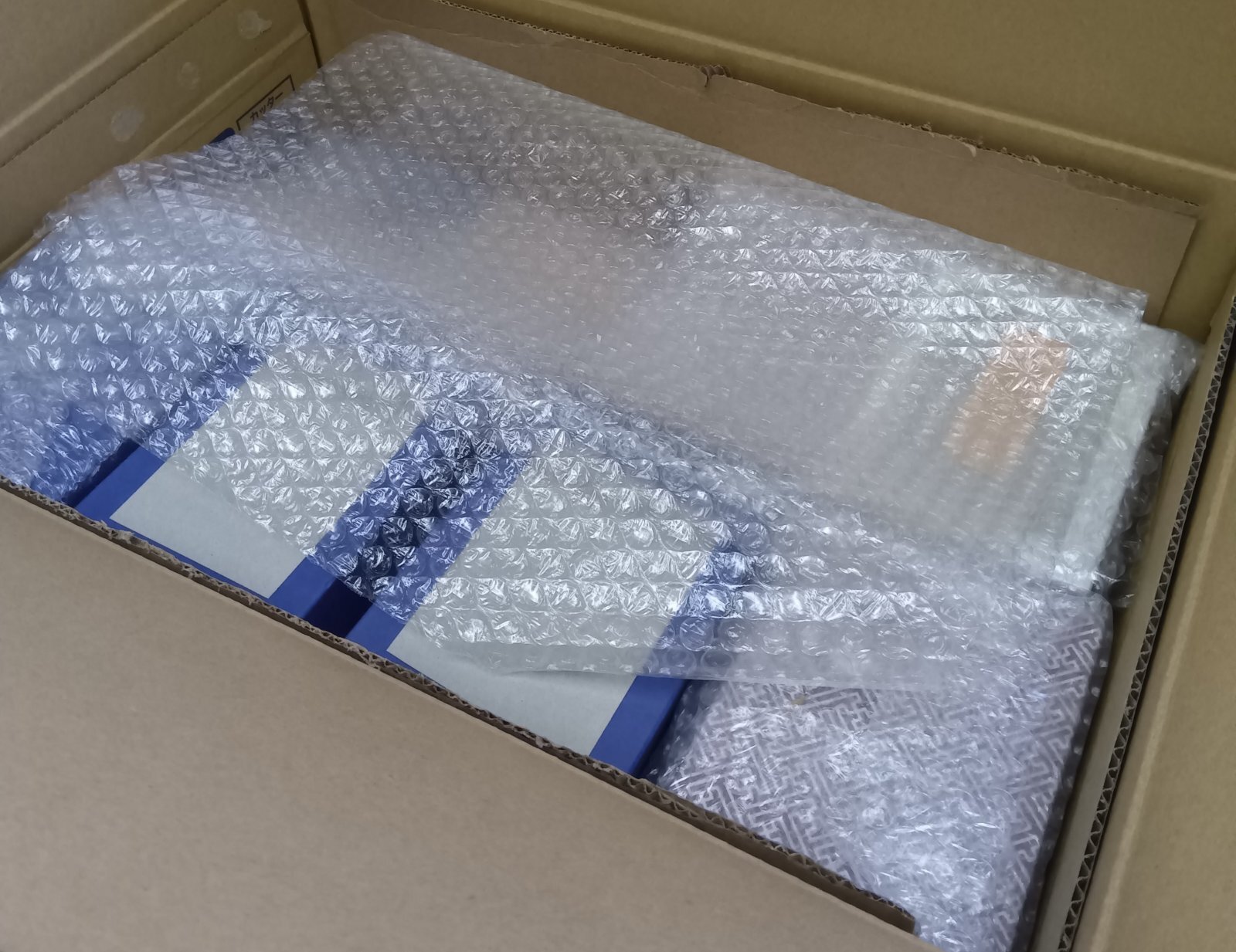Yosegi-sheet
I was out for a while today, so my work was somewhat limited. First, I continued from yesterday and attached the Kannuki(slide keys) panels to the 4-sun 27-step puzzle box. With this, the assembly of the 4-sun 27-step box is complete. Tomorrow, I will proceed with the priming process.
For this batch of 4-sun boxes, I ended up making four boxes with solid wood top and bottom panels. All the side panels are covered with a checkered yosegi (ichimatsu) veneer. As expected, using Agathis wood with a parquet veneer for the side panels is more ideal than solid wood. Among the structural components of a secret box, the moving side panels are particularly delicate and sensitive to environmental changes such as temperature and humidity. Therefore, using agathis wood, which is relatively stable (depending on the part), and protecting it with a parquet veneer provides greater reliability.
The original purpose of applying parquet veneer is, of course, to enhance the appearance, but it also serves to protect the secret box. Compared to other puzzle boxes, Himitsu-bako often use thinner components, making this protective function especially important. Additionally, for parts like the Kannuki panels we applied this time, the intricate parquet patterns help obscure the sliding sections, making them less noticeable.
The walnut side panels complement the solid wood top and bottom panels beautifully, but they tend to warp easily when thinned, which is always a challenge. Well, at least they are excellent for concealing the sliding parts!😊
Today, in addition to this tasks, I worked on packing for shipment. For individual customers, I usually use the smallest carton box for shipping. However, when sending orders to overseas shops, I use larger cardboard boxes, depending on the order size. Since the weight increases, the packages become more prone to damage during shipping, so I pay a lot of attention to protection.One key consideration is the thickness of the cardboard. There are very sturdy cardboard boxes specifically for international shipping, but they are heavy and can increase the shipping cost for customers. On the other hand, standard cardboard with a thickness of about 5mm feels a bit unreliable. Therefore, after packing the boxes inside the shipping carton, I further reinforce the interior by adding extra cardboard sheets. This way, even if the outer box gets damaged, the inner contents remain protected. Of course, all the puzzle boxes inside are also well-wrapped with bubble wrap.
Last week was very warm, and I thought spring had already arrived. However, this week has been cold again, and yesterday, there were even a few snowflakes. It seems that heating appliances are still necessary...😅
For this batch of 4-sun boxes, I ended up making four boxes with solid wood top and bottom panels. All the side panels are covered with a checkered yosegi (ichimatsu) veneer. As expected, using Agathis wood with a parquet veneer for the side panels is more ideal than solid wood. Among the structural components of a secret box, the moving side panels are particularly delicate and sensitive to environmental changes such as temperature and humidity. Therefore, using agathis wood, which is relatively stable (depending on the part), and protecting it with a parquet veneer provides greater reliability.
The original purpose of applying parquet veneer is, of course, to enhance the appearance, but it also serves to protect the secret box. Compared to other puzzle boxes, Himitsu-bako often use thinner components, making this protective function especially important. Additionally, for parts like the Kannuki panels we applied this time, the intricate parquet patterns help obscure the sliding sections, making them less noticeable.
The walnut side panels complement the solid wood top and bottom panels beautifully, but they tend to warp easily when thinned, which is always a challenge. Well, at least they are excellent for concealing the sliding parts!😊
Today, in addition to this tasks, I worked on packing for shipment. For individual customers, I usually use the smallest carton box for shipping. However, when sending orders to overseas shops, I use larger cardboard boxes, depending on the order size. Since the weight increases, the packages become more prone to damage during shipping, so I pay a lot of attention to protection.One key consideration is the thickness of the cardboard. There are very sturdy cardboard boxes specifically for international shipping, but they are heavy and can increase the shipping cost for customers. On the other hand, standard cardboard with a thickness of about 5mm feels a bit unreliable. Therefore, after packing the boxes inside the shipping carton, I further reinforce the interior by adding extra cardboard sheets. This way, even if the outer box gets damaged, the inner contents remain protected. Of course, all the puzzle boxes inside are also well-wrapped with bubble wrap.
Last week was very warm, and I thought spring had already arrived. However, this week has been cold again, and yesterday, there were even a few snowflakes. It seems that heating appliances are still necessary...😅

